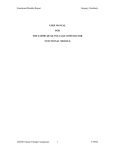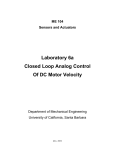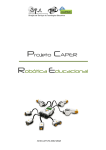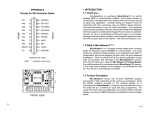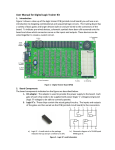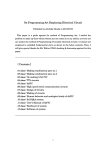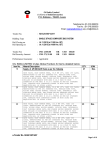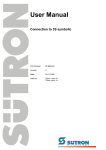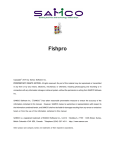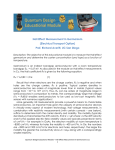Download Functional Module Report Gregory Crachiolo SN74LS04 Hex
Transcript
Functional Module Report Gregory Crachiolo USER MANUAL FOR THE SN74LS04 HEX INVERTER AND THE DM7407 HEX BUFFER FUNCTIONAL MODULE SN74LS04 Hex Inverter And DM7407 Hex Buffer 1 5/24/04 Functional Module Report Gregory Crachiolo TABLE OF CONTENTS 1. Index of Figures…………………………………………………………………..........3 2. Index of Tables.……………………………………………………………………….. 3 3. Introduction…………………………………………………………………………… 4-5 4. Theory and Predictions………………………………………………………………. 6 5. Functional Module Description……………………………………………………….7 6. Wiring Instructions……………………………………………………………………7 7. Chip Operating Conditions…………………………………………………………... 7-8 8. Connection Diagrams………………………………………………………………… 8 9. Apparatus………………………………………………………………………………9 10. Testing Sequence……………………………………………………………………… 9 11. List of Parts…………………………………………………………………………….10 12. References……………………………………………………………………………... 11 SN74LS04 Hex Inverter And DM7407 Hex Buffer 2 5/24/04 Functional Module Report Gregory Crachiolo Index of Figures Figure 1 Inverter Symbol……………………………………………………………5 Figure 2 Buffer Symbol………………………………………………………………5 Figure 3 Inverter Circuit…………………………………………………………… 5 Figure 4 Buffer Circuit………………………………………………………………5 Figure 5 SN74LS04 Hex Inverter connection diagram……………………………8 Figure 6 DM7407 Hex Buffer connection diagram……………………………….. 8 Index of Tables Table 1 Circuit Connections………………………………………………………. 7 Table 2 Inverter Operating Conditions…………………………………………... 7 Table 3 Buffer Operating Conditions…………………………………………….. 8 Table 4 Equipment List for Circuit Testing……………………………………… 9 Table 5 Test Results for Inverter…………………………………………………. 9 Table 6 Test Results for Buffer…………………………………………………….9 Table 7 Equipment List for Circuit Construction……………………………….. 10 Index of Images Picture 1 Transistor Module Box…………………………………………………… 10 SN74LS04 Hex Inverter And DM7407 Hex Buffer 3 5/24/04 Functional Module Report Gregory Crachiolo Introduction The essence of inverters and buffers are transistors. Each chip is a collection of many transistors. Transistors have copious practical applications, but their most basic application is a switching function or an amplifying function. Collections of transistors are used in computers to perform memory or computing functions. Every transistor has a base, emitter, and collector. Inverters and buffers have an open collector output. This means that the output contact on the inverter or buffer chip is connected to the collector of the last transistor in the circuit. In order for the inverter or buffer to perform properly, the output collector must be connected to a pull-up resistor. When transistors are operating at their saturated or cutoff states, they are known as ‘logic gates,’ or ‘gates.’ These are gates because they control the flow of signals from inputs to a single output. A single transistor functions as an inverter, or a ‘Not’ gate—an input of logic 1 (high voltage—greater than 2.5 V) is converted to a logic level of 0 (low voltage—less than .7 V). A low logic output is usually between 0V and .4V, and a high logic output is usually between 2.5V and 5V. An input between .7V and 2.5V (between logic 0 and 1) is a dead zone in which the output is undefined. This is not the case for all transistors, however. For complementary metal oxide semiconductors (CMOS), these limits are determined by their supply voltage and can be different. One transistor will function as an inverter. Two transistors in series will function as a buffer—an input of logic 1 or 0 is the same as the output: 1 or 0. Furthermore, a device that converts a binary input to a binary output based on the rules of mathematical logic is known as a combinational logic device. Buffers and inverters are combinational logic devices. SN74LS04 Hex Inverter And DM7407 Hex Buffer 4 5/24/04 Functional Module Report Gregory Crachiolo The symbols in fig. 1 and fig. 2 represent the collection of transistors that makeup inverters and buffers for the purposes of a circuit diagram. Notice the circle in the inverter diagram, this is the symbol that stands for inversion. Figure 1: Buffer symbol. Figure 2: Inverter symbol. A circuit diagram of the inverter circuit and the buffer circuit can be found in fig. 3 and fig. 4. +5 V Resistor (pull-up) 220 Ω V (in) V (out) Resistor (load) LED 220 Ω GND Figure 3: Inverter circuit with load. +5 V V (in) Resistor (pull-up) 220 Ω V (out) Resistor (load) LED 220 Ω GND Figure 4: Buffer circuit with load. SN74LS04 Hex Inverter And DM7407 Hex Buffer 5 5/24/04 Functional Module Report Gregory Crachiolo Theory and Predictions There are many types of transistors. Three types are as follows: bipolar, field effect (FET), and complementary metal-oxide semiconductor (CMOS). Variations of these exist also. Complementary refers to the use of two types of metal-oxide semiconductors (MOS). Both of these metals in the transistor behave oppositely. The transistors inside the hex inverter and buffer chips consist of doped metals imbedded inside SiO2. Metal-oxides are ‘doped’ with impurities— for example: n-type MOS are doped with antimony, phosphorous, and arsenic, whereas p-type MOS is doped with boron, gallium, and indium. These are a few that are used in the CMOS. The doping process is done to improve the transistors performance by adding electrons (n-type) or accepting electrons (p-type). An exact description of the contents of the buffer and inverter chips is too complex to ascertain—there are too many components to specifically quantify. Also, doping is only one step in the complex process that chips undergo when being constructed. Buffers and inverters are ‘driving’ chips. This means that they boost some characteristic of the circuit. In this case, the current is increased without compromising voltage. For many applications, many digital devices are run off of one output. When the supply is not adequate to perform all such functions, a buffer is used to boost the current so that each device may operate properly. The limit that some digital device has on its output is called its ‘fan-out.’ ‘Fan-out’ describes the maximum number of similar devices that may be driven by some output. A typical gate supplies approximately 1 mA—if a buffer is added, this may boost to up to 15 mA. For the buffer, if supply and ground are connected and there is either no input or 0V input, then the LED will illuminate because the open collector output is in its cutoff state. The current from the pull-up resistor must travel through the LED, then to ground. SN74LS04 Hex Inverter And DM7407 Hex Buffer 6 5/24/04 Functional Module Report Gregory Crachiolo Functional Module Description The functional module consists of: the SN74LS04 Hex Inverter and the DM7407 Hex Buffer, static resistors, a switch, voltage source and ground, red and green light emitting diodes (LED), red, black, and yellow wires, and a breadboard. Both the inverter and the buffer chips require a power supply of +5V and ground, as well as an input of +5V or 0V. The resistors are used in order to: pull-up the voltage, and protect the LED. Wiring Instructions Table 1: Outline for circuit connections Red Black Yellow Supply to Switch Supply to Inverter or Buffer Chip Supply to Pull-up Resistor Switch to Ground Inverter or Buffer Chip to Ground LED to Ground Pull-up Resistor to Output Output to Load Resistor Load Resistor to LED Switch to Input of Buffer or Inverter Chip Operating Conditions Table 2: Hex inverter safe operating specifications SN74LS04 Hex Inverter Symbol Parameter V(CC) Supply Voltage T(A) Operating Ambient Temperature Range I(OH) Output Current—High I(OL) Output Current—Low Minimum 4.75 0 SN74LS04 Hex Inverter And DM7407 Hex Buffer Typical 5 25 7 Maximum 5.25 70 Unit V °C -.4 8 mA mA 5/24/04 Functional Module Report Gregory Crachiolo Table 3: Hex Buffer safe operating specifications. DM7407 Hex Buffer Symbol Parameter Minimum V(CC) Supply Voltage 4.75 V(IH) High Lever Input Voltage 2 V(IL) Low Level Input Voltage V(OH) High Level Output Voltage I(OL) High Level Output Current T(A) Free Air Operating Temperature Typical 5 Maximum 5.25 .8 30 40 70 Connection Diagrams Figure 5: SN74LS04 Hex Inverter connection diagram. Figure 6: DM7407 Hex Buffer connection diagram. SN74LS04 Hex Inverter And DM7407 Hex Buffer 8 5/24/04 Unit V V V V mA °C Functional Module Report Gregory Crachiolo Apparatus Table 4: List of required equipment for inverter and buffer circuit analysis. Constructed Hex Inverter Circuit Box Constructed Hex Buffer Circuit Box Power Source Voltage Box with +5V supply and 0V ground Digital Multimeter or Equivalent Voltmeter Testing Sequence The process for testing both the hex buffer and hex inverter are the same. First, connect the breadboard to the power supply. Notice the buffers open-collector output is in its cut-off state initially, and the opposite is true for the inverter. Use the voltmeter to measure the input and output voltage levels of each chip. For the inverter circuit, switch the input to either +5 or 0V. For a binary input of 1, the LED should not be lit, and vice-versa. For the buffer circuit, a binary input of 1 should light the LED. A chart of values for the testing of the inverter and buffer can be found in tables 5 and 6. Table 5: Testing results for hex inverter chip Hex Inverter Test Results V (in) [Volts] 4.93 0 V (out) [Volts] .50 4.22 Green LED Off On Table 6: Testing results for hex buffer chip Hex Buffer Test Results V (in) [Volts] 4.94 0 V (out) [Volts] 3.62 .28 SN74LS04 Hex Inverter And DM7407 Hex Buffer Red LED On Off 9 5/24/04 Functional Module Report Gregory Crachiolo List of Parts Table 7: List of equipment for design and testing of hex buffer and hex inverter circuits Part Hex Inverter Chip Hex Buffer Chip Voltage Box Voltmeter Breadboard Static Load Resistor Static Pull-up Resistor LED Switch Red Wire Black Wire Yellow Wire Value N/A N/A +5, 0 N/A N/A 220 220 N/A N/A N/A N/A N/A Unit N/A N/A V N/A N/A Ω Ω N/A N/A N/A N/A N/A Picture 1: Transistor Module Box SN74LS04 Hex Inverter And DM7407 Hex Buffer 10 5/24/04 Functional Module Report Gregory Crachiolo References Robert H. Bisop. The Mechatronics Handbook. CRC Press, (2002) Peter Spasov. Microcontroller Technology, the 68HC11. 3rd Edition. Upper Saddle River, NJ. Prentice Hall, (2002). Michael B. Histand and David G. Alciatore. Introduction to Mechatronics and Measurement Systems. WCB/McGraw-Hill. (1999) SN74LS04 Hex Inverter Data Sheet: http://sisko.colorado.edu/ASEN3300/sn74ls04rev6.pdf DM7407 Hex Buffer Data Sheet: http://info.hobbyengineering.com/specs/Fairchild-7407.pdf SN74LS04 Hex Inverter And DM7407 Hex Buffer 11 5/24/04











